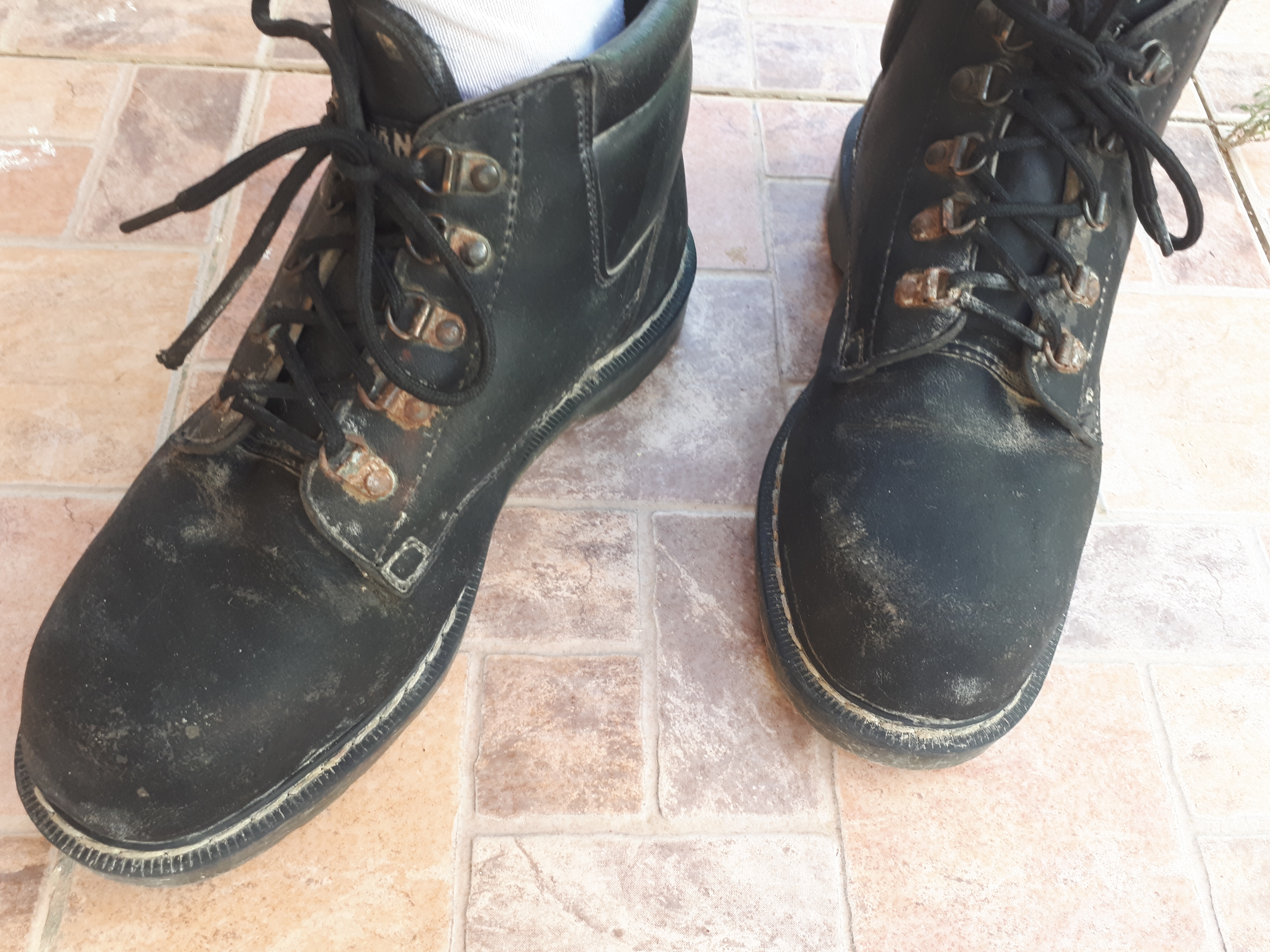Safety boots: safety degrees, vegan choices and how to ensure comfort wearing them

Boots in general have to be durable and comfortable to us as we wear them for most part of our everyday lives. In addition safety boots serve one more purpose – it is, as the name suggests, to keep us safe if something heavy or sharp falls on our feet, when we step on something sharp and simply by providing us more stability during situations we may fall due to slippery floors or uneven ground we step on. Safety boots are frequently required in an industrial work environment for potentially dangerous activities. Those workplaces have a distinct definition of required footwear during work hours, as it is at my current workplace. My employer requires us to wear safety boots, which are provided to us for free. Unfortunately, they always are animal based, so I had to find acceptable options for me by myself over the years. Some were more comfortable then others, some turned out to be unsuited for my levels of work activities, and some simply wasn't strong enough and got ruined shortly after the purchase. What I'm trying to say is that I've became kind of self told expert on the subject through some trial and error and I would like to pass on my acquired knowledge in this short guide. Hopefully it would be helpful to you.
First and foremost, as for all footwear and clothing, you should never compromise your comfort while wearing safety boots. It is even more important that safety ratings, which are listed below. Your comfort is very important for both your future foot health and your safety. Long time of wearing uncomfortable boots will compromise them both as well as your physical stability during your tasks.
Safety ratings
There are different safety grades in boots depending on the intended application. Those ratings are listed and described below for your convenience.
Safety grades- full list of all existing safety boot ratings:
- HRO – Heat Resistant Out-sole. Providing heat resistance to at least 300°C for 60 seconds.
- HI – Heat Insulation for up to 30 minutes in 150°C.
- CI – Cold Insulation. Insulates in -20°C for 30 minutes
- P – Penetration resistance. Mid-sole protection against sharp objects, like nails and other inserts. Tested to withstand penetration force up to 1100Nm
- CR – Cut Resistance upper
- A – Antistatic protection. Electrical resistance in range 0.1 to 1000 M Ohm.
- C – Conductive
- I – electricity Insulation
- E – Energy absorption of shoe heel up to 20J. Safety boots of this type are usually very comfortable.
- FO – Fuel Oil resistance
- WR – Water Resistance (it is not entirely water proof)
- WRU – Water Resistant Upper
- SRA / SRB / SRC – Slip Resistant footwear. Difference between the three are the way they are tested for slip resistivity.
- M – Metatarsal protection. Protection of metatarsal bones from fractures. Metatarsal bones are long and thin bones of our midfoot located above the toes.
- AN – Ankle protection.
- SB – Safety Basic toe protection of 200J impact and 15kN compression force.
- S1 – Offers combined features of SB + A + E + FO, meaning SB toe protection, antistatic, energy absorbent heel and fuel oil resistant footwear
- S2 – Offers all S1 qualities + WRU (water resistant upper)
- S3 - Offers all S2 qualities + P (midsole penetration protection)
- S4 – all S1 qualities + waterproof and leak proof
- S5 - all S4 qualities + P (midsole penetration resistance)
Only S4 and S5 are waterproof and leak proof, as opposed to WR and WRU which are water resistant but not entirely water proof.
After we was able to successfully identify required safety grade for our purpose, lets talk about boots comfort. Choosing your ideal size is most important. It can be easily done by trying specific shoe in the store or maybe trying your chosen brand in your local store and then buy it online to save money. But what can we do if there is no acceptable plant-based option in our close proximity? In that case we should carefully take our foot measurements to determine a wright size to buy. Remember, you have to keep in mind that shoe's width is important too.
How you can ensure your comfort wearing safety boots?
To choose the right shoe size, first measure your foot length in five simple steps:
1. Stand on a horizontal surface with your heel pressed against straight perpendicular edge (might be wall).
2. Put your weight on that foot, while your heel is still pressed against the edge.
3. Mark a line on the surface – you might want to place a paper on it in advance- next to your longest toe (will probably be big or index toe). Make sure your toes are straight.
4. Measure the length between the wall/edge till the line in millimeters, centimeters or inches.
5. It is advised to repeat it for both your feet, in case one is slightly longer then the other which is quite normal and common. The largest length is your foot length measurement.
Don't forget to pay attention to your foot width and an arch support (read about width and arch measuring in this article) or orthopedic insoles, if you need them. Special insoles can be purchased separately.
Shoe sizes can be very confusing as they frequently differ from brand to brand. For your convenience we've gathered the most frequent size's conversion. Please note that there is no international standard, so the numbers may very. When applicable you should mostly rely on inches or centimeters (or millimeters) measurements as they are more definitive, sometimes it is beneficial to contact a manufacturer for a precise measurements of their products.
Sizes conversion tables for men's and women's footwear:
Women's Shoe sizes:
| Length, cm | Length, in | US size | EU size | UK size |
|---|---|---|---|---|
| 21.2 | 8 3/16 | 4 | 35 | 2 |
| 22.0 | 8 1/2 | 5 | 36 | 3 |
| 22.9 | 8 7/8 | 6 | 37 | 4 |
| 23.7 | 9 1/4 | 7 | 38 | 5 |
| 24.6 | 9 1/2 | 8 | 39 | 6 |
| 25.4 | 9 7/8 | 9 | 40 | 7 |
| 26.2 | 10 3/16 | 10 | 41 | 8 |
| 27.0 | 10 1/2 | 11 | 42 | 9 |
| 27.6 | 10 7/8 | 12 | 43 | 10 |
Men's Shoe sizes:
| Length, cm | Length, in | US size | EU size | UK size |
|---|---|---|---|---|
| 22.0 | 8 5/8 | 37 | ||
| 22.7 | 8 15/16 | 38 | ||
| 23.5 | 9 1/4 | 6 | 39 | 5.5 |
| 24.4 | 9 5/8 | 7 | 40 | 6.5 |
| 25.4 | 9 15/16 | 8 | 41 | 7.5 |
| 26.0 | 10 1/4 | 9 | 42 | 8.5 |
| 27.0 | 10 9/16 | 10 | 43 | 9.5 |
| 27.9 | 10 15/16 | 11 | 44 | 10.5 |
| 28.6 | 11 1/4 | 12 | 45 | 11.5 |
| 29.4 | 11 9/16 | 13 | 46 | 12.5 |
| 30.2 | 11 7/8 | 14 | 47 | 13.5 |
| 31.0 | 12 3/16 | 15 | 48 | 14.5 |
| 31.7 | 12 1/2 | 16 | 49 | 15.5 |
If you foot length is in-between sizes – choose the larger size. If your feet measurements are a little bit different select the size of your larger foot.
More advise
While buying your safety boots it is important to pay attention to materials of a different components of it – if purchasing a cruelty free product is important to you. In most shoes shopping it is fairly complicated to check all the components' materials as they are many individual parts in the shoe where animal based products can be used: sole, toe cup, heel cap, tongue, shaft, shoelaces and last but not least the glue- which can be animal derived material.
Glue material is usually the hardest to identify and know whether or not it is cruelty free and vegan. Fortunately, in recent years there's been a shift to synthetic adhesives for footwear glue as they are more effective, profitable and reliable in production, yet more traditional animal based ingredients are still widespread. Most manufacturers will not reveal their glue recipe as it is frequently their trade secret. Still it is usually helpful to ask them whether or not it is actually vegan. In that case, besides founding that out you signal them that cruelty free materials are costumer's priority.
We encourage your to check the materials of all shoe parts listed above, maybe contact the manufacturer for more details if you are not quit sure about something.
